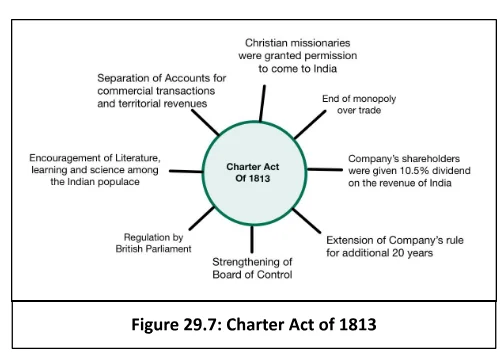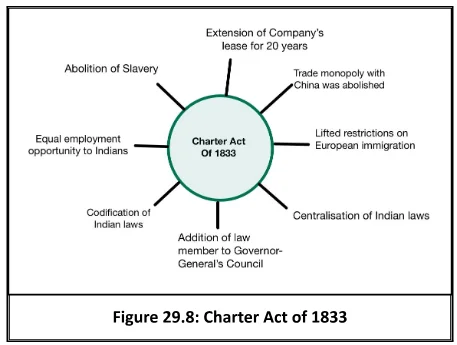The early 19th century marked significant transformations in the governance of British India. The series of Charter Acts—notably those of 1813, 1833, and 1853—introduced critical changes in administration, trade policies, and legal frameworks. These Acts reflected the evolving economic interests, ideological shifts, and political strategies of the British Empire, profoundly impacting India’s constitutional development.
The Charter Act of 1813
Background
- Economic Motivations:
- Industrial Revolution: Rapid industrialization in Britain increased the demand for new markets and raw materials.
- Access to Indian Markets: British traders sought unrestricted entry to India’s vast market to sell factory-made goods.
- Need for Raw Materials: India was viewed as a reliable supplier for Britain’s burgeoning industries.
- Ideological Influences:
- Utilitarian and Liberal Thought: Influential thinkers like Adam Smith, Jeremy Bentham, James Mill, John Stuart Mill, and Thomas Macaulay promoted ideas of science, reason, and governance.
- Belief in Western Superiority: Advocated that Western principles could improve and develop Indian society.
- Evangelical Impulses:
- Missionary Efforts: Figures like Charles Grant and William Wilberforce pushed for spreading Christianity and education in India.
- Moral Duty: Believed it was Britain’s responsibility to civilize India and eradicate ignorance and superstition.
Enroll now for UPSC Online Course
Key Provisions of the Act
- End of Trade Monopoly: Terminated the East India Company’s monopoly over trade in India, except for trade with China and the tea trade.
- Shareholder Dividend: Guaranteed a 10.5% annual dividend to Company shareholders from Indian revenues.
- Extension of Company’s Rule: Allowed the Company to retain territories and revenues for another 20 years under the British Crown’s sovereignty.
- Strengthening the Board of Control: Expanded the powers of the Board of Control over Company affairs.
- Support for Education and Science: Allocated one lakh rupees annually for promoting literature, learning, and science among Indians.
- Regulation by British Parliament: Required regulations made by Indian Councils to be presented before the British Parliament, clarifying the constitutional status of British territories in India.
- Separation of Accounts: Mandated separate accounting for commercial transactions and territorial revenues.
- Permission for Christian Missionaries: Allowed missionaries to enter India and preach Christianity.

Criticisms of the Charter Act of 1813
- Deindustrialization of India:
- Economic Shift: Reduced India to a raw material supplier under external economic control.
- Market Flooding: British goods dominated Indian markets; protective tariffs hindered Indian exports to Britain.
- Decline of Indian Industries: Traditional sectors like the cotton textile industry suffered due to inability to compete with British industrial goods.
- Vulnerability to Economic Fluctuations: Raw material producers faced risks from international market cycles.
- Chinese Trade and Opium Cultivation:
- Opium Trade Expansion: Initiated under Warren Hastings, with opium grown in Bihar and later Malwa.
- Smuggling into China: Private British traders illegally exported opium, leading to conflicts like the Opium Wars.
- Indentured Labor: Increase in emigration of opium growers from India in the 1830s.
- Funding for Education:
- Limited Impact: The allocation for education was minimal and primarily served the Company’s interests.
- Objective: Aimed to train locals to support Company administration, fostering loyalty rather than widespread educational development.
Significance
The Charter Act of 1813 marked a pivotal shift by opening Indian trade to all British merchants, ending the Company’s trade monopoly (except with China).
- It laid the groundwork for state-supported education in India.
- The Act clarified the constitutional position of British territories in India under the Crown’s sovereignty.
The Charter Act of 1833
Background
- Era of Reform:
- Influenced by the Industrial Revolution and the rise of the Whig government in 1830.
- The Reform Act of 1832 reflected liberal ideas emphasizing individual rights and laissez-faire economics.
- Debate Over Company’s Role:
- Discussions in Parliament on whether to dissolve the East India Company or reform its governance.
- Influential figures like Thomas Macaulay and James Mill advocated for the continuation of Company rule with significant reforms.
Key Provisions of the Act
- Extension of Company’s Lease: Renewed the Company’s lease for another 20 years, but with governance in the name of the British Crown.
- Guaranteed a 10.5% annual dividend to stockholders.
- End of Trade Monopoly: Abolished the Company’s monopoly over trade with China and the tea trade, fully ending its commercial activities.
- Lifting of Restrictions: Removed restrictions on European immigration and property acquisition in India, facilitating European colonization.
- Centralization of Government:
- Governor-General granted authority over all civil and military affairs.
- Bengal, Madras, Bombay, and other territories under direct control of the Governor-General.
- Revenues to be raised and controlled centrally.
- Madras and Bombay governments’ legislative powers reduced; could propose laws to the Governor-General.
- Addition of Law Member:
- Introduced a Law Member to the Governor-General’s Council for legal expertise (e.g., Thomas Babington Macaulay).
- Codification of Laws: Directed the codification and consolidation of Indian laws.
- Equal Employment Opportunity: Declared that no Indian citizen would be denied employment based on religion, color, birth, descent, etc.
- Abolition of Slavery: Encouraged measures to improve conditions of slaves and abolish slavery, formally achieved in 1843.

Significance
Economic Focus and Governance Separation: Ended the Company’s commercial functions, focusing solely on administration.
- Legal Reforms: Initiated the process of codifying laws, leading to more uniform legal systems (e.g., Indian Penal Code).
- Promotion of Equality: Opened government services to all, laying groundwork for future demands for Indian participation in governance.
- Centralization of Power: Marked the beginning of a centralized administrative system in India.
The Charter Act of 1853
Background
- Calls for Administrative Reform: Demand to end the Double Government structure involving the Court of Directors and the Board of Control.
- Recognized inefficiencies and delays due to overlapping authorities.
- Territorial Expansion: New territories acquired (e.g., Sindh in 1843, Punjab in 1849, and Pegu in Burma).
- Needed constitutional provisions for governance of these regions.
- Desire for Decentralization: Growing calls for involving Indians in governance and decentralizing administrative powers.
- Figures like Lord Derby advocated for granting Indians more responsibility.
Key Provisions of the Act
- Continued Company Rule: Allowed the East India Company to retain territories until Parliament decided otherwise.
- Reduction of Court of Directors: Reduced members from 24 to 18, with six appointed by the Crown.
- End of Company’s Patronage: Abolished the Company’s patronage over civil services.
- Introduced open competitive examinations for recruitment, including Indians.
- Legislative Council Expansion: Separated executive and legislative functions.
- Added six new legislative members, including local representation.
- Governor-General’s Council: The Law Member became a full member of the Governor-General’s Executive Council.
- Legislative Authority: Any legislation required the Governor-General’s assent.
- Governor-General retained the power to veto bills.
Significance
Compromise in Governance: Balanced between maintaining Company rule and increasing Crown control.
- Reduced the Court of Directors’ influence, enhancing governmental oversight.
- Foundation for Legislative Development: The expanded Legislative Council became a precursor to a more representative governance structure.
-
- Marked the beginning of parliamentary practices in India.
- Opening Civil Services: Allowed Indians to enter civil services through competitive exams, a step towards administrative inclusion.
Limitations of the Act
Legislative Restrictions: The Legislative Council had limited powers; significant constraints were placed on its authority.
Enroll now for UPSC Online Course
- Civil Service Examinations: Though open to Indians, exams were conducted in Britain, making it difficult for many to participate.
- Lack of Executive Representation: Indians were not included as executive members in the administration.
| Must Read | |
| Current Affairs | Editorial Analysis |
| Upsc Notes | Upsc Blogs |
| NCERT Notes | Free Main Answer Writing |
Conclusion
The Charter Acts of 1813, 1833, and 1853 were instrumental in reshaping the constitutional and administrative landscape of British India. They reflected the shifting priorities of the British Empire—from trade monopolies to governance and legal reforms. These Acts laid the groundwork for future constitutional developments and the eventual emergence of India as a modern state.
Sign up for the PWOnlyIAS Online Course by Physics Wallah and start your journey to IAS success today!
| Related Articles | |
| Charter Act | Warren Hastings |
| Industrialization in India | From Trade to Territory: The East India Company’s Rise in India |

 GS Foundation
GS Foundation Optional Course
Optional Course Combo Courses
Combo Courses Degree Program
Degree Program











